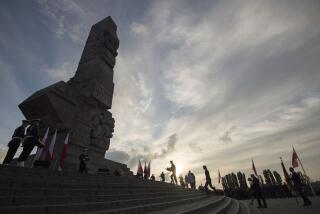Hungary Reburies Disgraced Nagy : Prime Minister Was Executed After ’56 Anti-Soviet Uprising
- Share via
BUDAPEST, Hungary — Hundreds of thousands of people attended a reburial ceremony today for Imre Nagy, the leader of the 1956 anti-Soviet revolt who was executed and buried in an unmarked grave.
The ceremony for Nagy and four colleagues in Heroes’ Square amounted to a catharsis for Hungary and mirrored remarkably swift political changes. For example, the ruling Communist Party, which is following the Soviet Union’s lead in adopting political reforms, began talks this week with opposition leaders on holding multiparty elections.
After the ceremony in the square, a motorcade took the coffins to Rakoskert Cemetery in suburban Budapest, where Nagy and the others were reburied in marked graves on the same spot where in 1958 their bodies were dumped in unmarked graves after their executions.
“We see this day as a dividing line, which we hope will mean we can begin to build a new and free Hungary,” said Andras Kaplar, a member of the opposition Hungarian Democratic Forum.
Praise From U.S.
In Washington, the State Department praised the reburial. “We see the rehabilitation” of Nagy “as part of a larger process, that of Hungary coming to grips with the truth of its past,” spokeswoman Margaret Tutwiler said.
Mourners filled the square in Budapest and filed past the coffins, where 650 wreaths from across Hungary were piled up. Many people came to today’s ceremony bearing flowers and wearing lapel pins with portraits of Nagy or the national colors.
A sixth, empty coffin lay beside the five others. It symbolized all those who were killed by Soviet tanks and troops that crushed the revolt and by later reprisals. The names and biographies of 250 young Hungarians executed after the revolt were solemnly read.
The mourners, estimated by Hungarian television at 250,000, included many of Hungary’s leading intellectuals, hundreds of former prisoners in Stalinist camps and one-time leaders of the failed revolt for a free Hungary.
A delegation of the Communist-led government headed by Premier Miklos Nemeth was among those paying their respects.
Italian Socialist leader Bettino Craxi, U.S. Ambassador Mark Palmer and diplomats from the Soviet Union and almost all other nations with embassies in Budapest attended the ceremony.
However, Romania, Albania and North Korea declined to send diplomats. China, in the throes of its own crackdown, also did not send a representative.
Reburied along with Nagy were his defense minister, Pal Maleter; his minister of state, Geza Losonczy; the head of his secretariat, Jozsef Szilagyi, and journalist and close Nagy associate Miklos Gimes.
More to Read
Sign up for Essential California
The most important California stories and recommendations in your inbox every morning.
You may occasionally receive promotional content from the Los Angeles Times.













